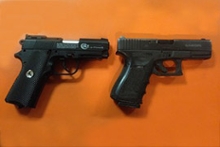
Only 41 percent of children in a recent study could distinguish the real gun (right) from the toy gun (left).
A new research study found that a majority of children could not tell the difference between a real gun and a toy gun when presented with comparison photos. In contrast, a majority of parents, caregivers, and the children themselves were confident their children could distinguish between real and toy guns. The researchers also found that, in the study group, fewer than half of the parents and caregivers who were firearm owners stored their guns safely as recommended by the American Academy of Pediatrics (AAP).
The study abstract, “A comparison of parental firearm storage patterns and children’s access to firearms,” will be presented Monday, Nov. 5 at the AAP 2018 National Conference & Exhibition in Orlando, Fla., by Kiesha Fraser Doh, MD, assistant professor of pediatrics and emergency medicine physician at Emory University School of Medicine.
Fraser Doh and her colleagues surveyed 297 caregiver-child pairs visiting one of three pediatric emergency departments – two suburban and one urban – in the southeastern United States over a three-month period in 2017. Gun owners represented 25 percent of respondents, and they were significantly more likely to be white, have an annual income of greater than $50,000, and have some college education, compared to non-gun owners. Gun owners also were more likely to allow their child to play with toy guns (50 percent, compared with 26 percent of non-gun owners).
When shown side-by-side photos of actual and fake firearms, only 41 percent of children between ages 7 and 17 years old correctly identified the real gun. In addition to asking about toy guns, the researchers asked the caregivers how easily they thought their child could access a real gun. Few caregivers (five percent, overall) felt their child could obtain a gun within 24 hours. However, the study found that 14 percent of children whose caregivers were gun owners and four percent of children whose caregivers were non-gun owners said they could access a gun within a day.
Among the study’s firearm owners, only 47 percent stored their gun locked, unloaded, and separate from ammunition as recommended by the AAP. Among children who reported having a gun in the home, 53 percent knew where it was stored and 45 percent knew where ammunition was stored.
“One of the most dramatic findings was how easily caregivers and children can confuse real guns with today’s realistic-looking toy guns,” says Fraser Doh. “Especially considering gun owners surveyed were nearly twice as likely as non-gun owners to let their children play with toy guns, safe storage of firearms in homes where children play is critical.”
